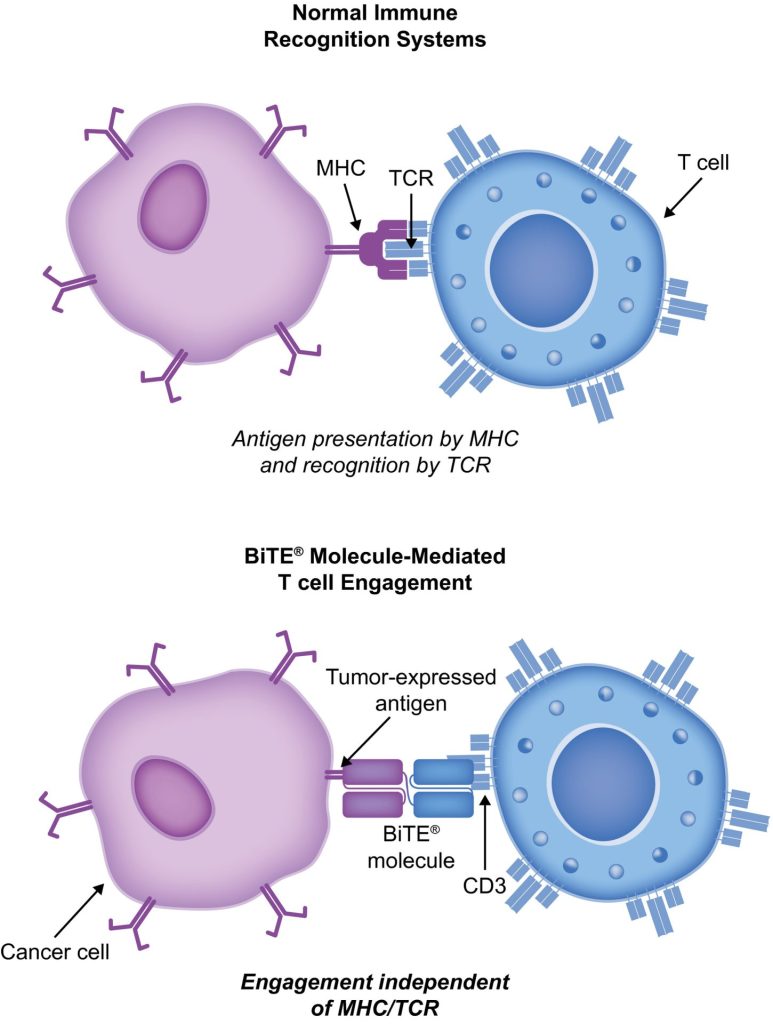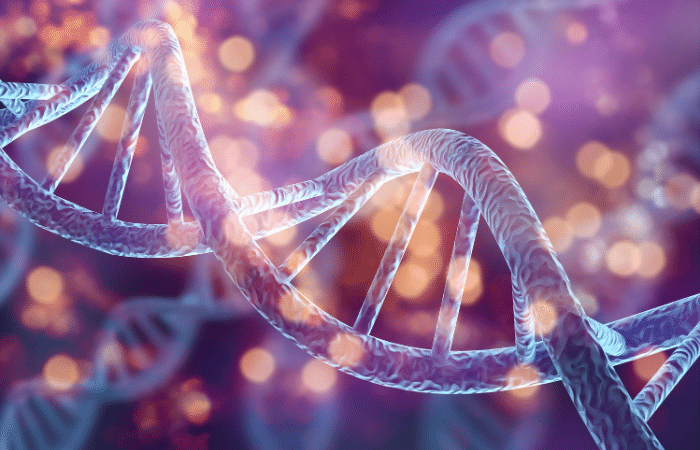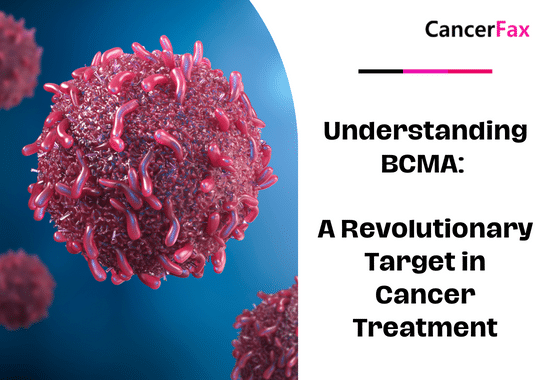Immuno-oncology is a way to treat cancer by using the body’s immune system. BiTE (bispecific T-cell engager) technology is a targeted immuno-oncology platform that binds a patient’s own T cells to cancer cells. Because BiTE technology is flexible, it is easy to make molecules that attack tumor-specific antigens, which makes immuno-oncotherapy possible. Blinatumomab was the first standard BiTE molecule to be approved. It targets CD19 surface antigens on B cells and is mostly unaffected by genetic changes or escape mechanisms inside cells. More BiTE molecules are being made to treat other blood cancers (like multiple myeloma, acute myeloid leukaemia, and B-cell limfom non-Hodgkin) and solid tumours (like prostate cancer, glioblastoma, stomach cancer, and small-cell lung cancer). BiTE molecules that have a longer half-life than the standard ones are also being made. With BiTE technology, advances in immuno-oncology could make it easier to treat both blood and solid tumours and make them more effective when used with other treatments.
Ce este terapia BiTe?
Immuno-oncology therapies are scientifically proven ways to treat different types of solid and cancerele de sânge. Hematologic cancers are a good fit for treatments that target the immune system because cancerous blood cells move around with immune cells. Several imunoterapia tratamente pentru cancer sunt în lucru.
Monoclonal antibody checkpoint inhibitors that stop the binding of checkpoint proteins (like PD-1 and CTLA-4) are useful against many types of cancer. They work well and are safe for many solid tumours, especially when they target PD-1. Non-small-cell lung, kidney, and bladder cancers have all been treated successfully with these drugs. But many people don’t react to checkpoint inhibitors or get sick again after taking them. Except for non-Hodgkin limfom, most results on hematologic cancers have been disappointing, especially for myeloma and leukaemia, where the overall response rate in approved indications ranges from 12.0% to 48.5%.8-15.
Other immuno-oncology treatments, on the other hand, have a higher success rate. Chimeric antigen-receptor (CAR) T-cell therapies change a patient’s T cells to attack a specific cellular antigen, such as CD19 in the treatment of B-cell malignancies and B-cell maturation antigen (BCMA) in the treatment of mielom multiplu (MM). CAR T-cell treatments have shown promise in treating hematologic cancers. They haven’t been as effective in treating solid tumours, but there have been some good results with neuroblastom, human epidermal growth factor receptor tumours, and non-small-cell lung cancer. The genetic modification and in vitro multiplication of T cells take a long and complicated manufacturing process. This is a downside of this therapy because it makes it harder for patients to get this treatment quickly and in large numbers. The fact that lymphodepletion through chemotherapy preparation must be done first as a requirement for improved effectiveness is also a drawback.
Terapiile BiTE (bispecific T-cell engager) leagă propriile celule T ale pacientului cu antigenele exprimate de tumori. Acest lucru activează capacitatea citotoxică a celulelor T ale pacientului de a ucide cancerul fără a modifica genele celulelor T sau a fi nevoie să le crească sau să le manipuleze în afara corpului. Moleculele BiTE pot fi folosite singure ca medicamente sau împreună cu alte tratamente pentru a le face mai eficiente.
Mecanismul de acțiune BiTe
BiTE molecules are antibody constructs with two binding domains. One recognises tumor-expressed antigens (such as BCMA, CD19, or -like protein [DLL3]), and the other, CD3, recognises T cells (Fig. 1). Two single-chain variable fragment (scFv) regions from monoclonal antibodies are connected by a flexible peptide linker to make the binding domains. The first scFv binding region can be changed to target any surface antigen, so it can be used right away to treat a wide range of tumours and can be used again later. The second scFv binding region always binds to CD3, which is a part of the T-cell receptor complex that never changes. When a BiTE molecule interacts with both a cytotoxic T cell and a tumour cell, the T cells begin to multiply. This increases the amount of effector cells and makes BiTE therapy more effective. Then, the death of cancer cells is started. BiTE molecules can get any T cells to do this because they don’t need co-stimulation or the usual processes of the major histocompatibility complex.

Blinatumomab is the first and only BiTE therapy that has been approved. It targets the CD19 receptor on both normal and cancerous B cells. It is a highly potent molecule with cytotoxic effects seen at low exposures (10–100 pg/mL)26. In its presence, T cells can perform serial-target lysis, quickly binding to and killing many cells. This is how BiTE therapies work, and it can be seen in other BiTE molecules that are still in research. In leucemie limfoblastica acuta (ALL), blinatumomab has been shown to be effective and safe. In 2014, the US Food and Drug Administration gave it fast approval, and in 2017, it got full approval for relapsed or refractory (R/R) B-cell precursor (BCP) ALL. In 2018, accelerated approval was given to blinatumomab for treating BCP-ALL with minimum residual disease (MRD). This was the first approval for this use. In November 2015, the European Medicines Agency also gave it a green light for BCP-ALL with a Philadelphia chromosome (Ph) that is negative and R/R. Blinatumomab is approved for R/R BCP-ALL in adults and children in 57 countries, including Japan, all countries in the European Union, Canada, and Australia.
Blinatumomab pentru tratamentul pacienților cu BCP-ALL
Blinatumomab a schimbat modul în care BCP-ALL este tratată. În comparație cu chimioterapia standard de îngrijire (SOC), a crescut supraviețuirea globală (OS) și a scăzut numărul anumitor reacții adverse (AE). Mai multe studii importante, inclusiv studii randomizate controlate, au arătat că blinatumomab este sigur și funcționează pentru BCP-ALL atât la adulți, cât și la copii. Terapia cu celule T CAR, există doar date din 2 studii cu un singur braț (clinictrials.gov ID-uri NCT01626495 și NCT01029366) în care au fost tratați 25 de copii (cu vârste între 5 și 22 de ani) și 5 adulți (cu vârste între 26 și 60 de ani) cu LLA BCP R/R și LLA cu celule T. Dar rezultatele sunt promițătoare (un răspuns complet [RC] în 90%, remisie susținută cu supraviețuire fără evenimente de 6 luni în 67% și o rată de supraviețuire globală [SG] de 78% [urmărire mediană, 7 luni; interval, 1-24 luni]).
Studiul TOWER (A Phase 3, Randomized, Open Label Study Investigating the Efficacy of the BiTE Antibody Blinatumomab Versus Standard of Care Chemotherapy in Adult Subjects With Relapsed/Refractory B-Precursor ALL; clinicaltrials.gov identifier NCT02013167) a comparat efectele chimioterapiei cu blinatumomab monoterapie cu S.O.C. R/R BCP-ALL. Deoarece oamenii trăiau mai mult, studiul a fost oprit devreme. EI din grupul cu blinatumomab au fost aceleași cu cele observate în studiile anterioare, iar blinatumomab a avut rate mai mici de EA ajustate în funcție de expunere decât SOC.34 Blinatumomab funcționează, de asemenea, pentru persoanele cu Ph-pozitiv, R/R BCP-ALL și pentru copiii cu Ph-negativ, R/R BCP-ALL.
30% to 50% of people with BCP-ALL in complete hematologic remission show persistent MRD. In the single-arm, phase 2 BLAST study (A Confirmatory Multicenter, Single-Arm Study to Assess the Efficacy, Safety, and Tolerability of the BiTE Antibody Blinatumomab in Adult Patients With MRD of B-Precursor Acute Lymphoblastic Leukaemia; clinicaltrials.gov identifier NCT01207388), blinatumomab was tested on patients with BCP-ALL in first or later complete After blinatumomab treatment, 78% of patients who were MRD positive became MRD negative. The 5-year OS study showed a median OS of 36.5 months, and more than half of those who had a complete MRD response after the first cycle of blinatumomab were still alive at 5 years, which suggests that the treatment might be able to cure some patients. AEs were seen that were linked to sindromul de eliberare de citokine (CRS).31 Other studies, like NCT03023878 and NCT03340766, are still looking at blinatumomab in first-line settings and in combination with other treatments.
CD19-targeted treatments have been linked to failure because of the loss of CD19 antigen after treatment. The failure rates for blinatumomab range from 8% to 35%, and for CAR terapii cu celule T, they range from 39% to 65%.36-40 We don’t fully understand what causes therapy to fail, but one possibility is immunoediting, in which antigen loss is caused by a T-cell-dependent process called immunoselection, which lets tumour cells get away.41 Lineage switch and epitope loss under therapy pressure have also been suggested as ways for tumours to escape treatment. However, a recent study on epitope loss found that some CD19 isoforms that help CAR T-cells escape were already present at the time of diagnosis. This suggests that combining treatments might be helpful. Another thing that can cause immunotherapy to fail is called “inhibitory T-cell signalling.” In this case, the blocking programmed death ligand-1 (PD-L1) is interesting because it is more common in B-cell ALL cells from patients who don’t respond to blinatumomab and can make CD3 BiTE molecules less effective.43 By making a CD28/PD-L1 BiTE that triggers the CD28 co-stimulatory signal instead of the inhibitory signaling pathway that is usually seen when a T cell binds to a PD-L1-expressing cancer cell, this inhibition could be turned off.43 Dual-targeted CAR T cells are also being looked into as a way to make up for the loss of tumour antigens. This can be done by modifying each T cell with 2 CAR molecules and 2 different binding domains (dual-signaling CAR) or by putting 2 different binding domains on 1 CAR molecule at the same time (TanCAR).
Evenimente adverse cu BiTE și managementul acestuia
În studiile clinice cu blinatumomab, cele mai frecvente reacții adverse sunt febra, numărul scăzut de celule albe din sânge și numărul scăzut de trombocite. Unele dintre cele mai importante riscuri sunt CRS, neurotoxicitatea și greșelile de droguri. Neurotoxicitatea se poate întâmpla și cu tratamentele cu celule T CAR specifice CD19, dar s-ar putea să nu fie din cauza CD19. Rezultatele unui studiu de fază 1/1b care este încă în desfășurare despre ținte CD20/CD3 au arătat că EA SNC de gradul 3 sau mai mare au fost rare (3% din toate EA de gradul 3). De cele mai multe ori, reacția blinatumomab la CRS este ușoară, dar, în cazuri rare, poate fi severă și chiar pune viața în pericol. Reacțiile inflamatorii pot fi diminuate cu corticosteroizi. Pentru a reduce șansa de CRS, cel mai bine este să administrați o perfuzie de prednison sau dexametazonă înainte de prima doză de blinatumomab și să creșteți doza încet. Această utilizare a corticosteroizilor înaintea altor molecule BiTE a dat un motiv pentru a utiliza dexametazona ca premedicație atunci când se utilizează alte molecule BiTE. Cu toate acestea, nu este clar dacă acest efect poate fi aplicat întregii platforme BiTE și sunt analizate și alte modalități de a trata CRS. Interleukina 6 este o citokină care provoacă CRS și este bogată la persoanele care au aceasta. Tocilizumab, care blochează receptorul de interleukină-6, a fost utilizat pentru a trata SRC, care este foarte rău după tratamentul cu celule T CAR.49 În spital, inhibitorii factorului de necroză tumorală au fost utilizați și pentru a trata SRC.


